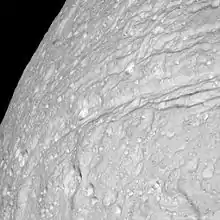chasma
English
Etymology

From Latin chasma, from Ancient Greek χάσμα (khásma, “abyss, cleft”), from Ancient Greek χᾰ́σκω (kháskō, “to gape, yawn”) (possibly from Proto-Indo-European *ǵʰan-, *gʰan- (“to gape, yawn”) + -σκω (-skō, “inchoative suffix forming a present-tense word”), from Proto-Indo-European *-sḱéti (“suffix forming a durative or iterative imperfective verb”); or from Proto-Indo-European *ǵʰeh₁y- (“to gape, yawn”)) + Ancient Greek -μᾰ (-ma, “suffix forming a noun denoting the result of an action”) (from Proto-Indo-European *-mn̥ (“suffix forming an action or result noun”)).
The obsolete “aurora” sense is from the fact that aurorae were thought to be rifts in the sky from which light shone through: see the 1822 quotation.
Pronunciation
- (Received Pronunciation) IPA(key): /ˈkazmə/
Audio (UK) (file)
- (General American) IPA(key): /ˈkæzmə/
- Hyphenation: chas‧ma
- Rhymes: -æzmə
Noun
chasma (plural chasmas or chasmata)
- (astronomy, geology) A long, narrow, steep-sided depression on a planet (often other than Earth), a moon, or another body in the Solar System.
- 1991 June 1, Steven K. Croft, “Tethys Geology and Tectonics Revisited”, in Reports of Planetary Geology and Geophysics Program (NASA Technical Memorandum; accession number 92N10765, document ID 19920001547), Washington, D.C.: Scientific and Technical Information Branch, National Aeronautics and Space Administration, OCLC 25563920, archived from the original on 26 September 2016, page 98:
- The most prominent tectonic feature on Tethys is the globe-girdling Ithaca Chasma, which is 60 to 100 km wide, 3–4 km deep, and can be traced through at least 270° of a rough great circle (Smith et al, 1982; Moore & Ahern, 1983). […] Odysseys Tangent Chasma. A prominent chasma 60–80 km wide and at least 800 km long (90° arc), visible in 80.27, is tangent to the rim of Odysseus, trending about 10° east of north. The chasma intersects a ridge-bounded trough radial to Odysseus […] and is then lost in the zone around the North Pole that is shadowed in all of the extant images.
- 2003, David Leverington, “The Space Age – Terrestrial Planets”, in Babylon to Voyager and Beyond: A History of Planetary Astronomy, Cambridge: Cambridge University Press, →ISBN, page 398:
- Venus shows clear signs of past tectonic activity in the highland regions. The deformational (tectonic) features showing[sic – meaning show] the results of both compressional and extensional forces. Rifting of the crust has occurred to produce relatively shallow chasmas and abundant faulting in the Aphrodite Terra and Beta Regio highlands […]
- 2007, Mary G. Chapman; John L. Smellie, “Mars Interior Layered Deposits and Terrestrial Sub-ice Volcanoes Compared: Observations and Interpretations of Similar Geomorphic Characteristics”, in Mary [G.] Chapman, editor, The Geology of Mars: Evidence from Earth-based Analogs (Cambridge Planetary Science), Cambridge; New York, N.Y.: Cambridge University Press, →ISBN, page 203:
- Assuming a subglacial or subaqueous setting for the ILDs [interior layered deposits], a simple tectonic control (and associated rupture of a confined aquifer) alone seems an unlikely trigger for ILD volcanism, or we should also observe ILDs in the linear chasmata, for which a tectonic setting is most likely and in which ILDs are absent. We suggest that the method of formation of the elliptical chasmata and the ILDs may be genetically related.
- 2014, Donald L[awson] Turcotte; Gerald Schubert, Geodynamics, 3rd edition, Cambridge: Cambridge University Press, →ISBN, page 83:
- The near circular trough of the Artemis chasma [on Venus] has a diameter of 2100 km. The concentric features outside the chasma are attributed to normal faulting associated with lithospheric flexure similar to that occurring seaward of subduction zones on the Earth.
-
- (astronomy, obsolete, rare) An aurora.
- 1814 December, Thomas Thomson, “On the Aurora Borealis”, in Annals of Philosophy; or, Magazine of Chemistry, Mineralogy, Mechanics, Natural History, Agriculure, and the Arts, volume IV, number XXIV, London: Printed by C. Baldwin, New Bridge-street, for Robert Baldwin, Paternoster-Row; sold also by W[illiam] Blackwood, Edinburgh; and J. Cumming, Dublin, OCLC 656483107, page 427:
- Thus Cornelius Gemma, Professor of Medicine in Louvain, mentions them [the aurora borealis] under the name of chasma, as appearing in Brabant on the 13th February and 28th September, 1575.
- 1822, Samuel Burder, “St. Luke. iii. 21”, in Oriental Literature, Applied to the Illustration of the Sacred Scriptures; Especially with Reference to Antiquities, Traditions, and Manners; Collected from the Most Celebrated Writers and Travellers, Ancient and Modern. Designed as a Sequel to Oriental Customs. [...] In Two Volumes, volume II, London: Printed for Longman, Hurst, Rees, Orme, and Brown, Paternoster-Row, OCLC 229906957, paragraph 1283, page 375:
- Livy (lib. xxii. cap. 1.) mentions a similar appearance among the prodigies which preceded Hannibal's entrance into Italy in the second Punic War. It was reported, says he, […] that at Falerii the Heaven seemed to be rent with a vast chasm; and that where it was opened, a great light shone forth. Such phenomena the Roman naturalists called chasmata, chasms, as we learn from Pliny [the Elder], Nat. Hist. lib. ii. cap. 26. and Seneca [the Younger], Nat. Quæst. lib. i. cap. 14.
- 1823, “Aurora Borealis”, in Encyclopædia Britannica: Or, A Dictionary of Arts, Sciences, and Miscellaneous Literature, volume III, 6th enl. and imp. edition, Edinburgh: Printed for Archibald Constable and Company; and Hurst, Robinson, and Company, Cheapside, London, OCLC 11927467, page 278, column 2:
- According to the state of the atmosphere, they [the aurora borealis] differ in colour. They often put on the colour of blood, and make a most dreadful appearance. The rustic sages become prophetic, and terrify the gazing spectators with the dread of war, pestilence, and famine. This superstition was not peculiar to the northern islands; nor are these appearances of recent date. The ancients called them Chasmata, and Trabes, and Bolides, according to their forms or colours.
-
- Obsolete form of chasm.
Related terms
- chasm
- chasmal
- chasmatical (unattested; appears only in dictionaries)
Translations
|
Further reading
 chasma on Wikipedia.Wikipedia
chasma on Wikipedia.Wikipedia
Anagrams
- ascham, chamas
Latin
Etymology
Borrowed from Ancient Greek χάσμα (khásma).
Noun
chasma n (genitive chasmatis); third declension
- A chasm, abyss
- A kind of meteor
Declension
Third-declension noun (neuter, imparisyllabic non-i-stem).
| Case | Singular | Plural |
|---|---|---|
| Nominative | chasma | chasmata |
| Genitive | chasmatis | chasmatum |
| Dative | chasmatī | chasmatibus |
| Accusative | chasma | chasmata |
| Ablative | chasmate | chasmatibus |
| Vocative | chasma | chasmata |
Descendants
- → English: chasm, chasma
References
- “chasma”, in Charlton T. Lewis and Charles Short (1879) A Latin Dictionary, Oxford: Clarendon Press
- chasma in Gaffiot, Félix (1934) Dictionnaire illustré latin-français, Hachette, page 299